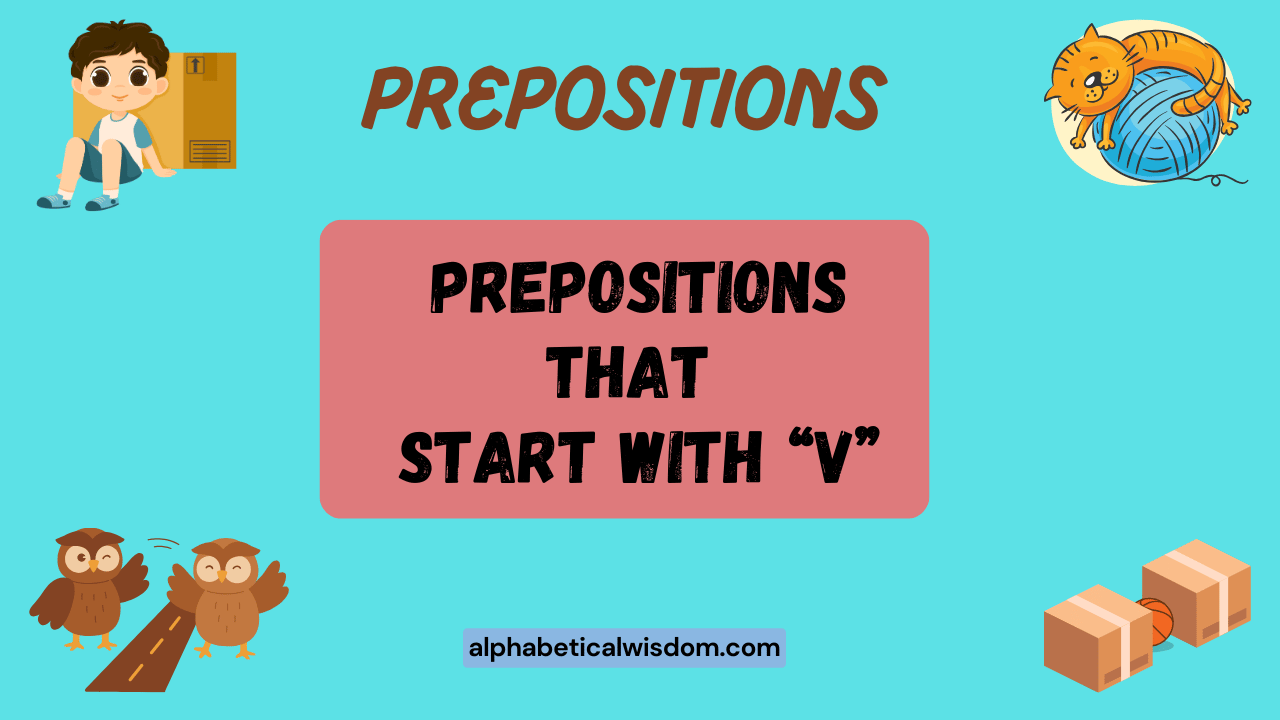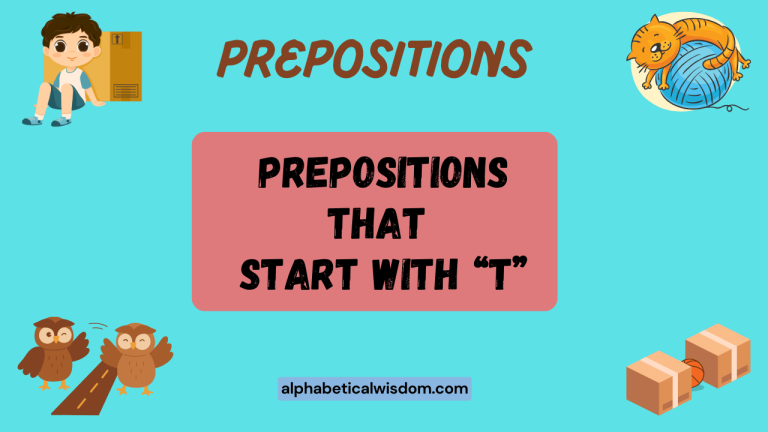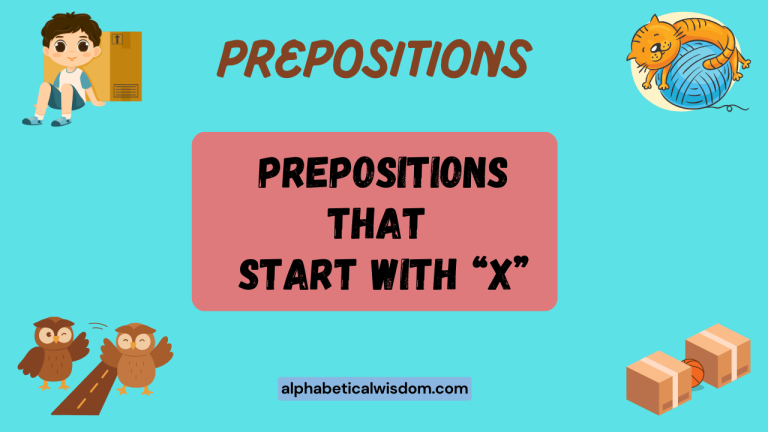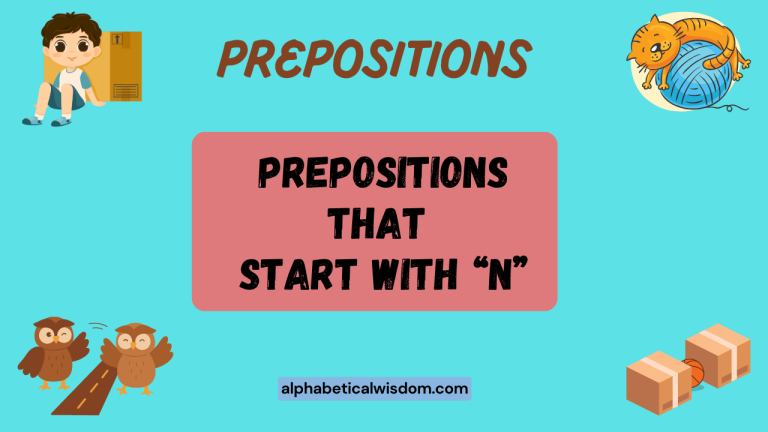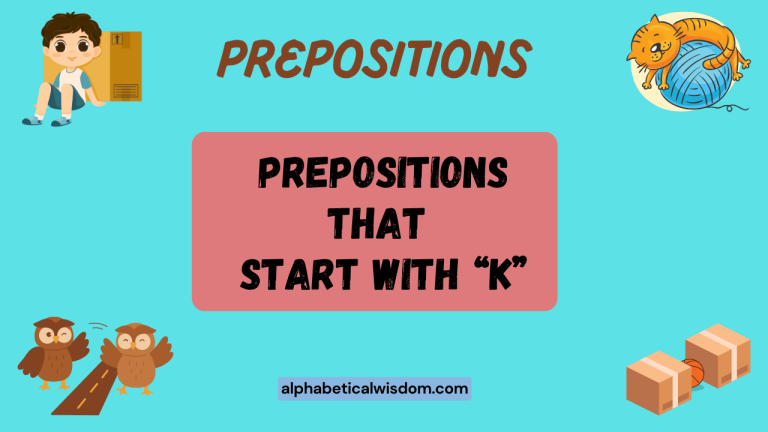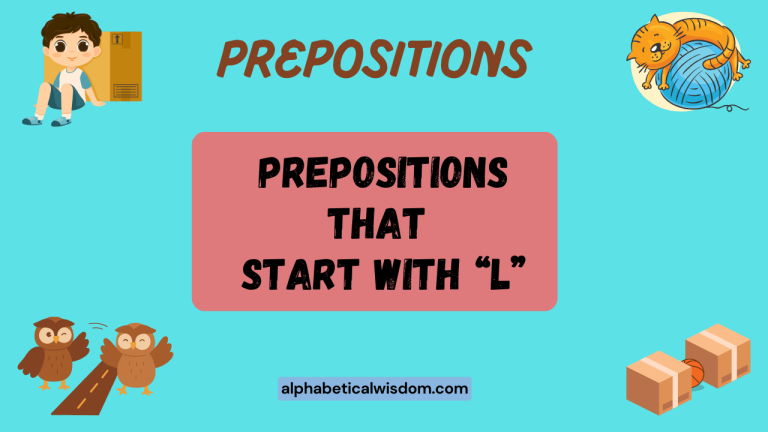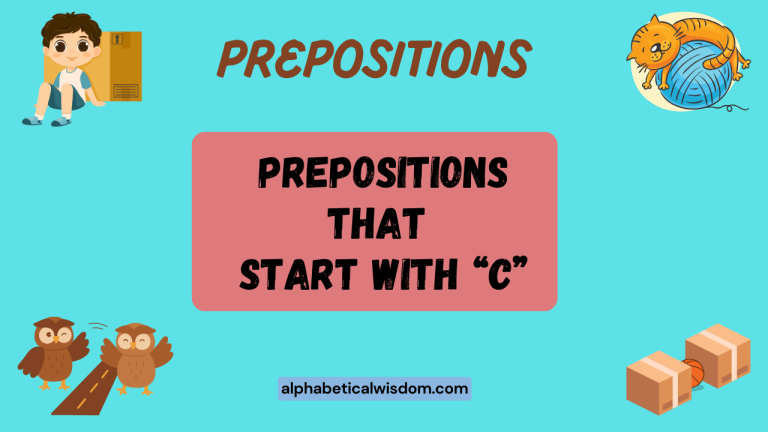Prepositions That Start With V: A Comprehensive Guide
Understanding prepositions is crucial for mastering English grammar. Prepositions connect nouns, pronouns, and phrases to other words in a sentence, clarifying relationships and adding depth to your communication.
While many prepositions are common, those that begin with the letter ‘V’ are less frequently used but equally important. This article delves into the world of prepositions starting with ‘V’, exploring their definitions, usage, and providing numerous examples to enhance your understanding.
This guide is designed for English language learners of all levels, from beginners seeking to expand their vocabulary to advanced speakers aiming to refine their grammatical accuracy.
By mastering these prepositions, you’ll be able to construct more precise and nuanced sentences, improving both your written and spoken English skills. We will explore the nuances of words like ‘via’, ‘versus’, and ‘vis-à-vis’, highlighting their specific applications and common pitfalls.
Get ready to unlock a new level of grammatical precision and confidence in your English communication!
Table of Contents
- Definition of Prepositions Starting with ‘V’
- Structural Breakdown of Prepositional Phrases
- Types and Categories of Prepositions Starting with ‘V’
- Examples of Prepositions Starting with ‘V’
- Usage Rules for Prepositions Starting with ‘V’
- Common Mistakes with Prepositions Starting with ‘V’
- Practice Exercises
- Advanced Topics
- Frequently Asked Questions
- Conclusion
Definition of Prepositions Starting with ‘V’
A preposition is a word that connects a noun, pronoun, or noun phrase to other words in a sentence. It typically indicates location, direction, time, or the relationship between objects or ideas.
Prepositions starting with ‘V’ are relatively few in number compared to other letters, but they are essential for expressing specific relationships and meanings. These prepositions, like all others, function to provide context and clarity within a sentence.
Prepositions can be classified based on their structure (simple, compound, phrasal) and their meaning (location, direction, time, etc.). However, the prepositions starting with ‘V’ primarily focus on direction, comparison, and relationship.
Understanding their specific meanings and contexts is key to using them correctly.
The role of a preposition is to govern a noun or pronoun, forming a prepositional phrase. This phrase acts as an adjective or adverb, modifying other elements within the sentence.
The prepositions starting with ‘V’, though limited, play a crucial role in creating nuanced and precise statements.
Structural Breakdown of Prepositional Phrases
A prepositional phrase consists of a preposition followed by its object (a noun, pronoun, or noun phrase). The structure is generally: Preposition + (Article) + Noun/Pronoun. The entire phrase functions as a single unit, modifying either a noun (adjectival phrase) or a verb, adjective, or adverb (adverbial phrase).
For instance, in the sentence “We traveled to Rome via Paris,” “via Paris” is a prepositional phrase. “Via” is the preposition, and “Paris” is the object of the preposition. This phrase acts as an adverbial modifier, indicating how they traveled to Rome.
Prepositional phrases can be more complex, including adjectives or other modifiers within the noun phrase. For example, “The package arrived via a very circuitous route.” Here, “a very circuitous route” is the object of the preposition “via,” and the entire phrase still functions as an adverbial modifier.
Understanding the structural components of prepositional phrases allows for better comprehension and construction of grammatically correct sentences. Recognizing the role of the preposition and its object is crucial for interpreting the meaning of the phrase within the larger context of the sentence.
Types and Categories of Prepositions Starting with ‘V’
While the number of prepositions starting with ‘V’ is limited, each has a distinct meaning and usage. The primary prepositions in this category are ‘via’, ‘versus’, and ‘vis-à-vis’.
Via
‘Via’ means “by way of” or “through.” It indicates a route or intermediary point in a journey or process. It is often used to describe how something is transmitted or achieved.
For example, “We sent the package via express mail.” Here, ‘via’ indicates the method of delivery.
Versus
‘Versus’ means “against” or “in contrast to.” It is commonly used to indicate opposition or comparison, particularly in legal, sporting, or competitive contexts. It is often abbreviated as “vs.”
For example, “The final game is Lakers versus Celtics.” In this case, ‘versus’ indicates the two competing teams.
Vis-à-vis
‘Vis-à-vis’ is a French term meaning “in relation to” or “in comparison with.” It indicates a relationship or position relative to something else. It can also mean “face to face.”
For example, “The company’s performance vis-à-vis its competitors was excellent.” Here, ‘vis-à-vis’ indicates a comparison between the company’s performance and that of its competitors.
Examples of Prepositions Starting with ‘V’
To solidify your understanding, let’s examine a variety of examples for each preposition.
Examples Using ‘Via’
‘Via’ is used to indicate the route, method, or intermediary through which something occurs. It helps to specify the means or pathway taken.
The table below provides a range of examples demonstrating the diverse applications of ‘via’.
| Sentence | Explanation |
|---|---|
| We flew to Tokyo via Seoul. | Indicates the stopover city on the flight. |
| The message was delivered via a third party. | Indicates the intermediary through whom the message was sent. |
| The water flows to the ocean via the river. | Indicates the natural channel through which the water travels. |
| I learned about the event via social media. | Indicates the platform where the information was obtained. |
| The company expanded its operations via strategic partnerships. | Indicates the method used for business growth. |
| The goods were transported via train. | Indicates the mode of transportation. |
| She contacted him via email. | Indicates the method of communication. |
| The news spread via word of mouth. | Indicates how the information was disseminated. |
| The software was distributed via the internet. | Indicates the distribution channel. |
| He accessed the files via a secure server. | Indicates the access point. |
| The funds were transferred via wire transfer. | Indicates the method of transferring money. |
| The data was collected via surveys. | Indicates the method of data collection. |
| The information was confirmed via multiple sources. | Indicates the means of verification. |
| The project was completed via collaborative efforts. | Indicates the method of project completion. |
| The problem was solved via a systematic approach. | Indicates the method used to resolve the issue. |
| We gained access via a backdoor entry. | Indicates an alternative route of gaining access. |
| They communicated via coded messages. | Indicates a method for secret communication. |
| The truth was revealed via investigation. | Indicates a method of discovering the truth. |
| The book became popular via online reviews. | Indicates a method of gaining popularity. |
| The contract was signed via electronic signature. | Indicates a method of signing the contract. |
| The company grew its customer base via targeted advertising. | Indicates a specific method of increasing customer base. |
| She earned her degree via online courses. | Indicates a specific method of education. |
| They reached the summit via the western ridge. | Indicates a specific route to reach a mountain summit. |
| The light entered the room via a small window. | Indicates the point through which light entered the room. |
| The secret was leaked via an anonymous source. | Indicates how the secret was made known. |
Examples Using ‘Versus’
‘Versus’ is primarily used to show opposition or contrast between two entities, often in competitive or argumentative contexts. It highlights the difference or conflict between the subjects being compared.
Below are examples illustrating the use of ‘versus’ in various contexts.
| Sentence | Explanation |
|---|---|
| The court case is Smith versus Jones. | Indicates the two parties involved in the legal dispute. |
| It’s a battle of good versus evil. | Presents a conflict between opposing forces. |
| The debate was about nature versus nurture. | Contrasts two different perspectives on development. |
| Our team is playing against them: us versus them. | Highlights the competitive aspect of the game. |
| The argument was quality versus quantity. | Contrasts two different approaches or priorities. |
| Cats versus dogs: a classic debate. | Presents a common comparison of preferences. |
| The election is Democrats versus Republicans. | Indicates the political parties in opposition. |
| The study compared traditional methods versus modern techniques. | Contrasts two different approaches in research. |
| The discussion revolved around theory versus practice. | Highlights the difference between theoretical and practical applications. |
| The competition is speed versus accuracy. | Contrasts two different skills being tested. |
| The film explores the theme of freedom versus control. | Presents a conflict between two opposing concepts. |
| The experiment tested the effects of drug A versus drug B. | Compares the effects of two different substances. |
| The survey asked people to choose between option X versus option Y. | Presents a choice between two alternatives. |
| The report analyzed the performance of company A versus company B. | Compares the performance of two different companies. |
| The legal battle was intellectual property versus fair use. | Contrasts two opposing legal concepts. |
| The marketing campaign pitted product A versus product B. | Highlights the competitive aspect of the products. |
| The economic debate centered on capitalism versus socialism. | Contrasts two different economic systems. |
| The philosophical discussion explored determinism versus free will. | Presents a fundamental philosophical debate. |
| The ethical dilemma was honesty versus loyalty. | Highlights a conflict between two moral principles. |
| The scientific study compared the results of group A versus group B. | Compares the outcomes of two different groups. |
| The political race is candidate X versus candidate Y. | Indicates the candidates in opposition during an election. |
| The art exhibition featured modern art versus classical art. | Contrasts two forms of art from different periods. |
| The business model is subscription versus one-time purchase. | Contrasts two different pricing methods. |
| The health study compared exercise versus diet for weight loss. | Compares two methods of weight loss. |
| The final decision was simplicity versus complexity. | Highlights a choice between two different approaches. |
Examples Using ‘Vis-à-vis’
‘Vis-à-vis’ is used to indicate a relationship or comparison, often in a formal or academic context. It establishes the position or standing of one thing relative to another.
The following table presents examples showcasing the use of ‘vis-à-vis’ in various contexts.
| Sentence | Explanation |
|---|---|
| The company’s strategy vis-à-vis the new market is unclear. | Indicates the company’s approach in relation to the new market. |
| Her performance vis-à-vis her colleagues was outstanding. | Compares her performance to that of her colleagues. |
| The government’s policy vis-à-vis immigration has been criticized. | Indicates the government’s stance on immigration. |
| The artist’s work vis-à-vis the traditional style is innovative. | Compares the artist’s work to the conventional style. |
| The student’s understanding vis-à-vis the subject matter was impressive. | Indicates the student’s comprehension of the subject. |
| The organization’s responsibility vis-à-vis the community is significant. | Indicates the organization’s obligations to the community. |
| The country’s position vis-à-vis the international treaty is complex. | Indicates the country’s stance on the treaty. |
| The manager’s role vis-à-vis the team is to provide guidance. | Indicates the manager’s responsibilities to the team. |
| The author’s perspective vis-à-vis the historical events is unique. | Indicates the author’s viewpoint on the events. |
| The scientist’s findings vis-à-vis the previous research are groundbreaking. | Compares the scientist’s findings to earlier research. |
| The child’s behavior vis-à-vis strangers was cautious. | Indicates the child’s conduct around strangers. |
| The software’s compatibility vis-à-vis older systems is limited. | Indicates the software’s compatibility with older systems. |
| The company’s commitment vis-à-vis environmental protection is strong. | Indicates the company’s dedication to environmental protection. |
| The project’s progress vis-à-vis the timeline is on track. | Compares the project’s advancement to the schedule. |
| The patient’s condition vis-à-vis the treatment is improving. | Indicates the patient’s health in relation to the treatment. |
| The system’s security vis-à-vis potential threats is robust. | Indicates the system’s defenses against threats. |
| The artist’s interpretation vis-à-vis the original text is intriguing. | Indicates how the artist’s work relates to the original piece. |
| The student’s attitude vis-à-vis learning new things is enthusiastic. | Indicates the student’s approach to learning. |
| The building’s design vis-à-vis the surrounding landscape is harmonious. | Indicates how the building integrates with its surroundings. |
| The organization’s accountability vis-à-vis its donors is crucial. | Indicates the organization’s responsibility to its donors. |
| The product’s quality vis-à-vis its price is excellent. | Compares the product’s value to its cost. |
| The website’s accessibility vis-à-vis users with disabilities is improving. | Indicates the website’s usability for people with disabilities. |
| The teacher’s approach vis-à-vis student engagement is innovative. | Indicates the teacher’s method for engaging students. |
| The chef’s skill vis-à-vis creating unique dishes is remarkable. | Indicates the chef’s ability to craft original dishes. |
| The city’s infrastructure vis-à-vis population growth is strained. | Indicates how the city’s infrastructure is coping with population increases. |
Usage Rules for Prepositions Starting with ‘V’
Each preposition has specific rules governing its usage. Understanding these rules is essential for using them correctly and avoiding common errors.
Usage Rules for ‘Via’
‘Via’ should be used to indicate a route, method, or intermediary. It is often used with verbs of motion or communication.
It should not be used to indicate a final destination.
Correct: We traveled to Rome via Paris.
Incorrect: We arrived via Rome. (Use ‘in’ or ‘at’ instead)
‘Via’ is often followed by a noun or noun phrase indicating the route or method.
Correct: The package was sent via express mail.
Incorrect: The package was sent via quickly.
Usage Rules for ‘Versus’
‘Versus’ should be used to indicate opposition or contrast between two entities. It is often used in legal, sporting, or argumentative contexts.
Correct: The game is Lakers versus Celtics.
Incorrect: The game is Lakers via Celtics.
‘Versus’ is often abbreviated as “vs.” in informal contexts.
Correct: Lakers vs. Celtics
It is important to ensure that ‘versus’ is used to compare or contrast two distinct entities, not to indicate a route or method.
Usage Rules for ‘Vis-à-vis’
‘Vis-à-vis’ should be used to indicate a relationship or comparison between two entities. It is often used in formal or academic writing.
Correct: The company’s performance vis-à-vis its competitors was excellent.
Incorrect: The company’s performance versus its competitors was excellent. (While understandable, ‘vis-à-vis’ is more appropriate here.)
‘Vis-à-vis’ is typically followed by a noun or noun phrase indicating the entity to which the subject is being compared or related.
It is important to maintain the correct spelling and hyphenation of ‘vis-à-vis’.
Common Mistakes with Prepositions Starting with ‘V’
Several common mistakes occur when using prepositions starting with ‘V’. Being aware of these errors can help you avoid them.
Mistake 1: Using ‘via’ to indicate a final destination.
Incorrect: We arrived via London.
Correct: We arrived in London.
Mistake 2: Confusing ‘versus’ with ‘via’.
Incorrect: The package was sent versus express mail.
Correct: The package was sent via express mail.
Mistake 3: Misspelling ‘vis-à-vis’.
Incorrect: vis a vis, visa-vis
Correct: vis-à-vis
Mistake 4: Using ‘vis-à-vis’ in informal contexts where a simpler preposition would suffice.
Less Ideal: The issue vis-à-vis the budget needs to be addressed.
Better: The issue regarding the budget needs to be addressed.
Mistake 5: Using ‘versus’ to show a relationship when ‘vis-à-vis’ is more appropriate.
Incorrect: The company’s strategy versus the new market is unclear.
Correct: The company’s strategy vis-à-vis the new market is unclear.
Practice Exercises
To test your understanding, complete the following exercises. Fill in the blanks with the correct preposition (‘via’, ‘versus’, or ‘vis-à-vis’).
| Question | Answer |
|---|---|
| 1. We sent the letter ______ registered mail. | via |
| 2. The final match is Brazil ______ Argentina. | versus |
| 3. The company’s performance ______ last year was significantly improved. | vis-à-vis |
| 4. They traveled to Italy ______ France and Switzerland. | via |
| 5. The debate was about freedom ______ security. | versus |
| 6. The organization’s responsibility ______ its members is paramount. | vis-à-vis |
| 7. She learned about the conference ______ a friend. | via |
| 8. The case is the plaintiff ______ the defendant. | versus |
| 9. The government’s policy ______ education needs reform. | vis-à-vis |
| 10. The package was delivered ______ a courier service. | via |
| 11. The discussion was about quality ______ price. | versus |
| 12. The book’s reception ______ critics was mixed. | vis-à-vis |
| 13. The news spread ______ social media platforms. | via |
| 14. The contest is experience ______ youth. | versus |
| 15. The product’s popularity ______ competitors is evident. | vis-à-vis |
| 16. We received the information ______ reliable sources. | via |
| 17. The argument was logic ______ emotion. | versus |
| 18. The company’s commitment ______ sustainability is strong. | vis-à-vis |
| 19. They communicated ______ encrypted messages. | via |
| 20. The election is candidate A ______ candidate B. | versus |
Advanced Topics
For advanced learners, understanding the nuances and subtle usages of these prepositions is crucial. This includes recognizing the contexts where they are most appropriate and avoiding overly formal or stilted language.
Consider the use of ‘via’ in more complex sentences, where it might connect multiple clauses or phrases, creating a more nuanced meaning. For example, “The project achieved its goals, via a combination of innovative strategies and dedicated teamwork.” Here, ‘via’ connects the outcome (achieving goals) with the means (strategies and teamwork).
Similarly, ‘vis-à-vis’ can be used in sophisticated analyses to compare complex concepts or entities. For instance, “The philosopher’s theory of ethics vis-à-vis contemporary moral frameworks presents a compelling alternative.” This usage demonstrates a deep understanding of the preposition’s function in establishing intricate relationships.
Furthermore, exploring the historical evolution of these prepositions can provide valuable insights into their current usage. Understanding the etymology and changing meanings of words like ‘via’ and ‘vis-à-vis’ can enhance your appreciation for their subtle nuances.
Another advanced topic is the use of these prepositions in specialized fields, such as law, business, or academia. Each field may have its own specific conventions and preferred usages, which advanced learners should be aware of.
Frequently Asked Questions
Here are some frequently asked questions about prepositions starting with ‘V’.
- What is the difference between ‘via’ and ‘through’?
‘Via’ indicates a specific route, method, or intermediary, while ‘through’ implies movement within or across something. For example, you travel via a city but walk through a forest.
- Can ‘versus’ be used in contexts other than competition?
Yes, ‘versus’ can also be used to contrast ideas, concepts, or perspectives, not just in competitive situations. For example, “The debate was about theory versus practice.”
- Is ‘vis-à-vis’ always formal?
Yes, ‘vis-à-vis’ is generally considered formal and is more appropriate in academic or professional contexts. In informal settings, simpler prepositions like ‘regarding’ or ‘compared to’ may be more suitable.
- How do I remember the correct spelling of ‘vis-à-vis’?
Break it down: ‘vis’ (related to ‘vision’ or seeing), ‘à’ (French for ‘to’), and ‘vis’ again. Remember the hyphens and the accented ‘à’.
- Can ‘via’ be used with abstract concepts?
Yes, ‘via’ can be used with abstract concepts to indicate the means or method by which something is achieved or understood. For example, “We gained knowledge via research.”
- What are some alternatives to ‘vis-à-vis’?
Alternatives to ‘vis-à-vis’ include ‘in relation to’, ‘with respect to’, ‘regarding’, ‘concerning’, and ‘compared to’, depending on the specific context.
- Is it correct to say “via the means of”?
While understandable, “via the means of” is somewhat redundant. It’s generally better to simply use “via” followed by the specific means. For example, “via email” is preferable to “via the means of email.”
- Can ‘versus’ be used in business contexts?
Yes, ‘versus’ is commonly used in business contexts to compare the performance of different companies, strategies, or products. For example, “The report compared the sales of product A versus product B.”
- When should I use ‘vis-à-vis’ instead of ‘compared to’?
Use ‘vis-à-vis’ when you want to establish a formal relationship or comparison between two entities, particularly in an analytical or evaluative context. ‘Compared to’ is more general and can be used in a wider range of situations.
- Is it acceptable to use “vs.” in formal writing?
No, “vs.” is generally considered informal and should be avoided in formal writing. Use the full word “versus” instead.
- Can I use ‘via’ to describe a person who helped me?
While it’s possible, it’s not the most common or natural usage. You could say “I learned about it via John,” but it’s often better to say “I learned about it from John” or “through John.”
Conclusion
Mastering prepositions starting with ‘V’ – ‘via’, ‘versus’, and ‘vis-à-vis’ – adds precision and sophistication to your English communication. Understanding their distinct meanings, usage rules, and common pitfalls is crucial for effective language use.
While these prepositions may be less frequent than others, they play a vital role in expressing specific relationships and comparisons.
By studying the examples provided, practicing the exercises, and reviewing the usage rules, you can confidently incorporate these prepositions into your vocabulary. Remember to consider the context and formality of the situation when choosing the appropriate preposition.
With continued practice and attention to detail, you’ll enhance your grammatical accuracy and fluency in English.
Continue to explore the nuances of English grammar and expand your vocabulary. Consistent practice and a keen eye for detail will lead to greater confidence and proficiency in your language skills.
Keep learning and exploring the richness of the English language!
